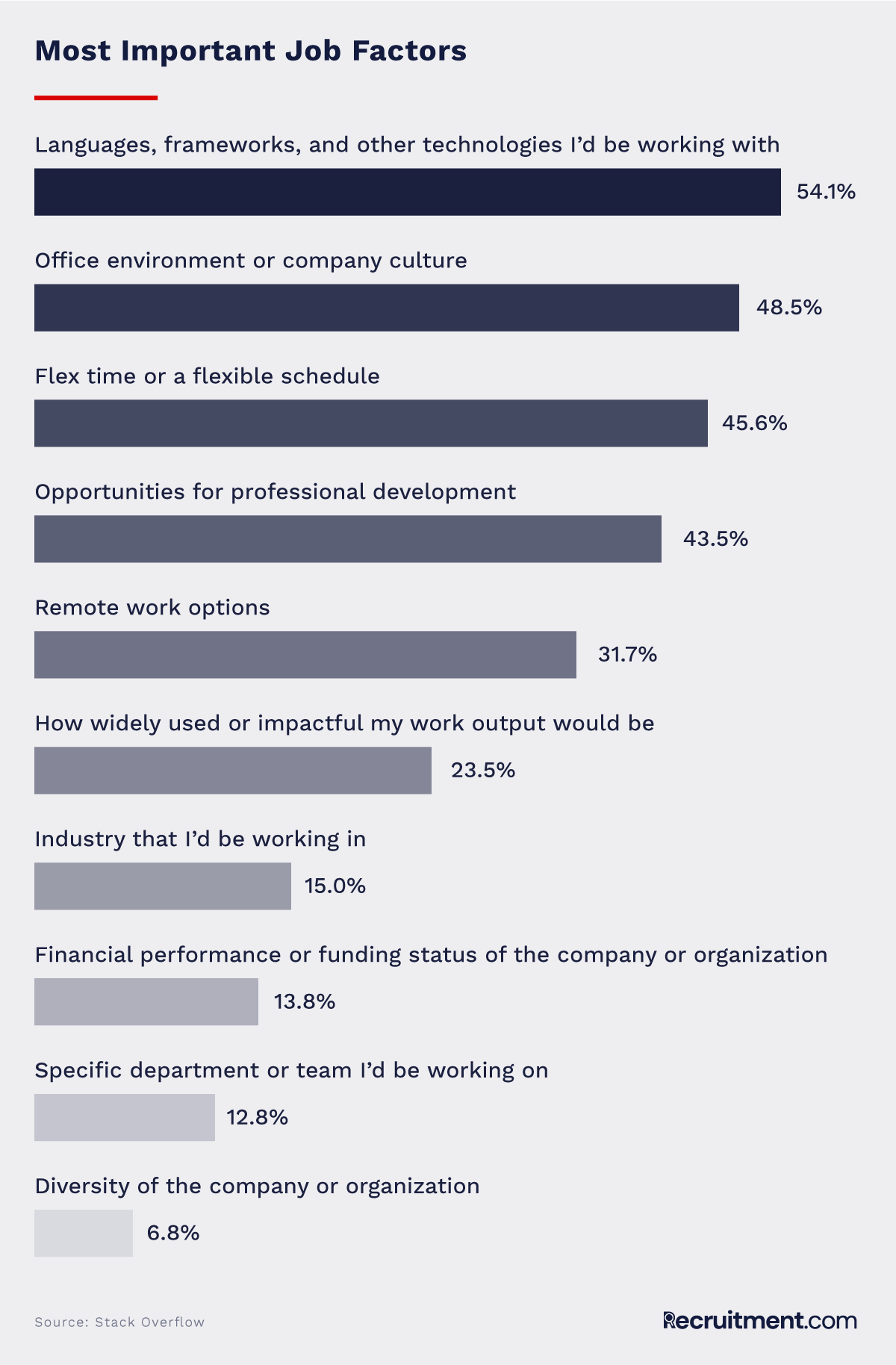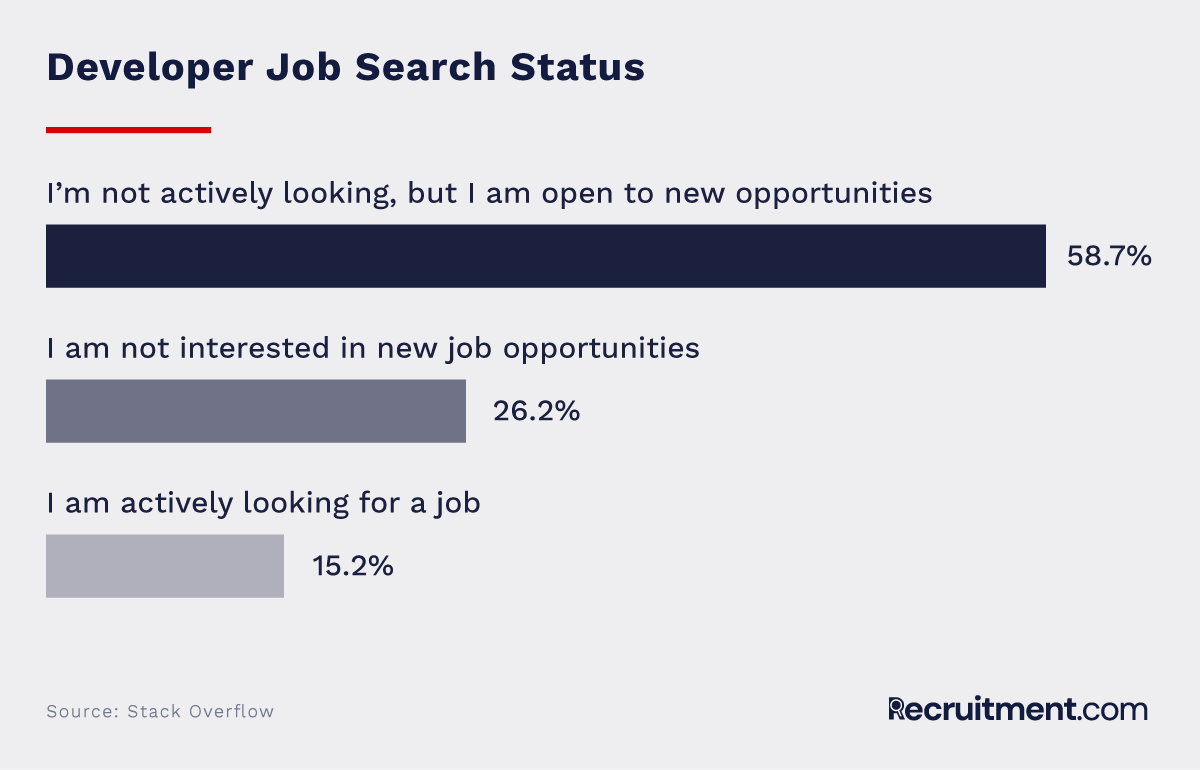The Recruiter’s Guide To Hiring Software Developers

Ritika Puri has written for LinkedIn, Twitter, PNC, Forbes, Entrepreneur, and more. She also advises on HR and communications strategies.
The tech economy is booming — which means that your job as a tech recruiter is likely getting tougher. One of the challenges that you’re likely facing is your ability to connect your company with the right audience. Given that programming has been rated to be the top job in the United States with an unemployment rate of just 1.6%, the best developers are choosing opportunities selectively.
Not to mention, not every developer is going to be a strong fit for your company — every programmer has a unique set of expertise ranging from industry experiences to preferred workstyles and programming languages. Your candidate population and pipeline, for instance, may not be robust enough to meet your organization’s hiring needs. If your company can’t hire the right people, you are likely encountering opportunity costs that inhibit your ability to scale.
“Finding enough quality developers in any one geographic location is extremely challenging,” says Robert Blackburn, CEO of Blackburn Labs, a software development company.
Blackburn, who has also held developer recruiting roles at major corporations, elaborates that this limitation is forcing companies to get creative about their hiring processes and team structures.
“We’re seeing more and more companies embrace remote development teams, so they can hire from the talent pool across the country or even internationally,” he says.
For this reason, it’s important for your talent team to build an inbound candidate pipeline — you never know how and when the ideal hire will find you. If you’re engaging in outbound recruiting efforts, you’ll want to empower developers to self-direct their own decision processes.
As a recruiter, you need to work smarter, not harder. You need to implement a system that takes care of the heavy lift in helping you source and hire developers. Here’s a scalable, repeatable process that any company can put in place to source and hire the best developers.
1. Get crystal-clear on your company’s long and short-term hiring needs
When it comes to choosing a job, the best candidates don’t want to take risks. They want to ensure that they’ll have a stable role at a company, where they can do their best work, make an impact, and grow in their careers.
That’s why, as a recruiter, it’s your responsibility to communicate the exact needs of your organization. To build this picture, work with your team to answer the following questions:
- What are the short, medium, and long-term goals of your workforce?
- How will a developer contribute to the long-term roadmap of your company?
- Why does your company build its infrastructure on a particular development framework?
- What parts of your technical plan are likely to change and why?
- What career path do you hope that new hires will take at your company?
- How big will your company need to be in 2, 5, and 7 years?
- What types of employees will enjoy being at your company for the long-haul and why?
- What experience will your company need at each stage
Most likely, you’ll need to devote several meetings to working through these questions at all levels of your organization from team leadership to senior management and your executive team. If your company is large, going through a growth spurt, or venture-funded, you’ll want to have these meetings twice a year — at the beginning of the year to set goals and in the middle of the year to double-check expectations.
If you aren’t clear on your hiring needs, you run the risk of hiring the wrong people for your company’s future trajectory. Imagine the pain that people would face in the midst of a mass layoff — this is the exact situation that your company needs to avoid.
“Workforce planning is a continuous optimization process organizations use to align their goals and needs with the goals and needs of their workforce, explains Andrew McDermott, staff writer at Recruitment. “It is an iterative process that relies on a partnership with human resources and the financial side of the organization.”
It’s a systematic analysis of an organization that focuses on five components: size, type, experience, knowledge and skills. Read more about workforce planning.
2. Write job descriptions that clearly speak to developers’ passions
The most effective job descriptions are the ones that aim to educate and provide an accurate window into your company. A well-crafted job description can help you set expectations, ensuring that applicants have an understanding of what life is like within your company.
Make sure that your job description, company website, and recruiting communications emphasize how every single job function adds up to a bigger picture. Give candidates a clear picture of the contributions that they’ll make — and how a career path at your company has the potential to unfold.
“Candidates have the opportunity to learn more about you from several touchpoints,” explains Mario Grunitz, who runs WeAreBrain and manages a team of 75 software developers. “That means you have several ways to impress them. It all starts with your job descriptions. We spend a lot of time crafting ours so that it’s clear who we’re looking for, why a person would like to work with us and what our company culture is all about.”
As you write your job description, make sure to focus on value propositions that prospective applicants care about. Stack Overflow, an online community of developers, has found in its annual survey of 90,000 people that programmers care about the following when choosing jobs:

Given that developers ranked their programming environment as the top factor for choosing a potential role, you’ll want to be clear in discussing your company’s underlying technologies, such as frameworks you use like PHP, jQuery, React or Angular.
In your job description, make sure that you:
- Introduce your company — share some facts and a brief history
- Describe the role, what responsibilities this person will own, and what projects they’ll be tackling
- Be clear about responsibilities, skills, and qualifications
- Pay special attention to the technologies that developers will be using
- Describe benefits
- Discuss what life on the job looks like, including your company’s culture and values
3. Ensure that salaries are competitive without being restrictive
One of the toughest challenges that your recruiting team may be facing is to set a budget for each role. On the one hand, it’s tough to zero-in on a precise number: a number of factors influence geography including skill level, experience, work history, and geography. Not to mention, payment structures vary based on where each employee is based.
Despite the lack of visibility that you may have, you still need to be clear about what your team can afford to hire — people aren’t going to inquire before applying. List a number too low, and you may scare away prospective hires. List a number too high, and you may risk over budgeting for a role.
There are a few steps that you can take to remain on target.
- Research comparable salaries for the exact position, in a range of potential geographies, that you’re hiring. Use GlassDoor, PayScale, LinkedIn, and AngelList as reference points.
- In your job description, specify a range for the role, emphasizing that the salary you’re offering is commensurate with experience.
- Localize your job listing so that people who view it have a frame of reference in their currency
When choosing a salary target — and determining whether to pay someone hourly or an annual wage — make sure that you’re in compliance with local laws and that you’re paying close attention to relevant taxes. Make sure that you evaluate each candidate holistically, and always focus on the value that individual brings to the table.
4. Pay people what they deserve
People are human beings, and each one who you hire has the potential to add value to your organization. Don’t assume, just because you can hire from anywhere in the world, that you can cut corners by saving on wages.
Because remote work opens doors for you to hire from anywhere in the world, you have a wider applicant pool. That means you can hire the right person for the job, no matter what salary they desire. As a recruiter, it’s valuable for you to maintain a budget range that’s extensive enough to hire the “right” person.
For instance, your company will gain more value spending $150,000 a year hiring an experienced developer who makes close to zero errors, coding in half the time than a junior developer who takes longer, makes more mistakes, and may need several months to ramp up.
Remember, however, that the salary you offer is only part of your recruiting equation. For this reason, when you talk about pay, make sure that the discussion is in the overall context of the value that your company can offer potential hires.
“High salaries and employee benefits aren't enough anymore,” explains Boris Shiklo, CTO at software development and IT consulting company ScienceSoft. “To attract such candidates, we work on building a diverse pool of projects with world-famous customers they would be inspired to engage in.”
5. Post the job where developers are
Stack Overflow’s 2019 Developer Survey found that only 15.2% of candidates are actively looking for a job. But almost three-fourths of developers are interested in learning about new job opportunities.

To effectively reach developers, you’ll need to meet them where they are. So how do you find the right people for your organization? Here are a few processes that you can incorporate into your recruiting practices:
- Speaking engagements. Ask employees to host webinars or speak at conferences, always mentioning what roles are open at your company — developers love learning about opportunities from fellow engineers who they respect and admire.
- Talent networks. Be present on talent networks that developers are likely to be browsing consistently. Make sure to check whether these networks have online communities on social media platforms like Facebook. Sign up, so that you can consistently monitor conversations.
- Freelance websites. Monitor freelance sites like to build up an extended team of talent, especially if you have overflow work or need extra hands while filling a permanent role. Freelance websites are especially valuable for reaching developers who may be employed full-time but have side gigs. These are individuals who you may be able to bring on full-time, in the future.
- Job boards. Be present on job boards that cater to technical talent such as ai-jobs.net, Dice.com, and LinkedIn. Depending on the job board that you join, you may consider investing in a small advertising campaign to reach people while they are browsing the web, naturally. Keep in mind; however, that job boards and sponsored listings are valuable if you need to widen your net from the people you’re attracting on an inbound basis.
- Developer communities. Spend time browsing developer communities such as Github, Gitlab, and Stack Overflow. See what questions developers are asking and problems that people are solving that are similar to the needs of your company. If the discussions are too technical for you to follow, loop in your hiring manager or development team to gain an understanding of patterns that may be valuable to watch.
- Open source projects. Stack Overflow found that 65% of professional developers contribute to open source projects outside of work. You can connect with these developers by joining and monitoring projects that are relevant to your company. If you’re not sure where to look, talk to technical teammates within your company. Make sure that you reach out actively to compliment people on their contributions and code.
- Blogging. Consider maintaining an engineering blog, in which your team discusses technical challenges that they are navigating. As an example, take a look at Code as Craft, Etsy’s engineering blog.
- Meetups. If you want to connect with developers, consider hosting and attending a local meetup. Stack Overflow has found that many developers work on code outside of work, with 80% of respondents saying that they code as a hobby. Attend or host events where developers have the opportunity to present what they’re working on, in and outside of the office.
- Twitter. While developers tend to be quiet on social media, they are on platforms looking for inspiration. Every once in a while, spend time browsing popular companies, influencers, projects, and publications in tech. Browse through names of interesting followers and commenters. Build relationships with these individuals, and comment on their posts — so you can get to know them, too.

6. Be communicative throughout your process
Once you’ve created a pipeline of candidates for key roles, what happens next?
As it turns out, that’s the question your potential hires are asking, too. To be successful with your hiring efforts, it’s critical that you make a positive impression with every interaction with a person you’re trying to recruit. The small details matter — often more than you may realize if you’re a recruiter who is responsible for communicating with multiple candidates.
Here’s what you need to communicate, to be prepared, even before you reach out to someone to schedule an interview.
- Share details into your interview process. Believe it or not, developers will often pick and choose opportunities based on the rigor of your interviewing process. It’s not like they’re looking for an easy way out; rather, they’re seeking to work for a company that respects and values their time.
For instance, top candidates may seek compensation for their time completing a project — if you don’t offer, they might consider that to be a red flag. They are also interested in learning about their teammates — the people who are interviewing them — to see how they’ll fit into your team. They’re also likely interested in learning about whether they’ll need to participate in a whiteboard interview. Some developers don’t conform to that style.
One of the most reassuring and helpful steps you can take as a recruiter is to share a potential list of interview questions. Consider starting with, and passing along, this interview guide.
- Be upfront about timing. As a recruiter, it’s critical that you deliver on your promises by sticking to a schedule. If you’re going to make an offer by X date, make sure that you make good on what you promise.
That means, before you’re even ready to make an offer, you need to make sure
that you have your ducks in a row. What details should you include in your offer letter? How much time do candidates have to make a decision, and what requirements must they meet to complete to be eligible for the role?
You can save time by having an offer letter ready off the bat. Here’s one you can try out and adapt to your company’s voice from Recruitment. It walks you through the basics of the details that you need to include, so that you don’t need to think about them.
- Define your onboarding process. Make sure that you define your onboarding process well in advance of conducting your first interview and extending an offer.
As awesome as your company may be, you need to remember that talented
people are unlikely to leave the safety and stability of a comfortable job. You need to show that you care about developing your new hire’s career and that you set up every individual for success.
For this reason, you’ll want to be transparent about your onboarding process within your job description itself. What access to training and mentorship will new hires have? What will the first week to three months at a company look like? What does onboarding mean for your company?
For inspiration, take a look at this guide to onboarding that the team at Recruitment put together.
Conclusion: Meet Developers Where They Are

Ritika Puri has written for LinkedIn, Twitter, PNC, Forbes, Entrepreneur, and more. She also advises on HR and communications strategies.





